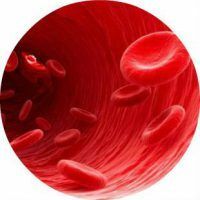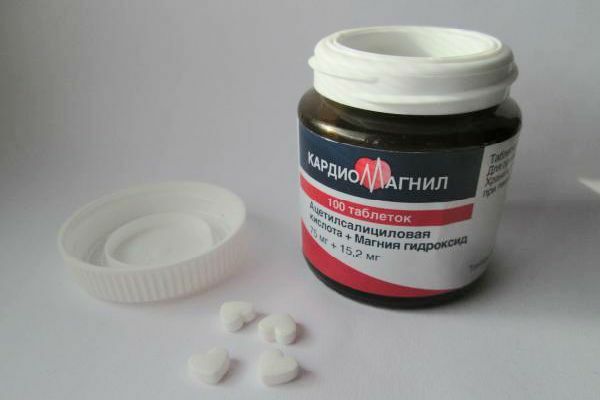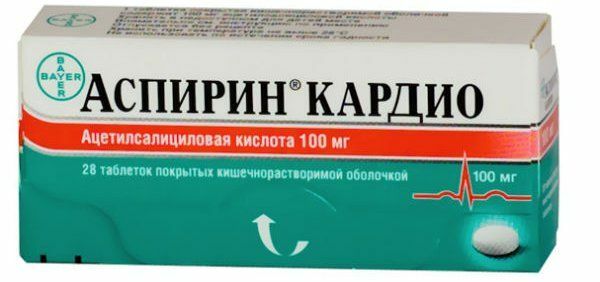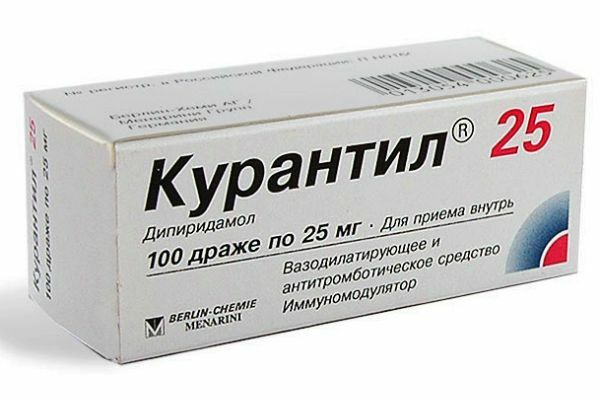
Hemoglobin is a complex iron-containing protein concentrated in red blood cells - erythrocytes. Hemoglobin takes part in the gas exchange process, performing a transport function. In the pulmonary circulation, a hemoglobin complex is formed with oxygen, which then spreads across all organs and tissues. Passing through the capillary network of a large circle of blood circulation, oxygen is replaced by carbon dioxide and enters the cells, and carbon dioxide is eliminated from the body.
- hemoglobin Norma
- Reasons for increasing
- Adults
- have
- children during pregnancy
- Symptoms
- How dangerous
- Treatment
- Pharmacotherapy
- cardiomagnyl
- Aspirin Cardio
- Trental
- Kurantil
- Folk remedies
- decoction of herbs
- The infusion of chamomile and mistletoe
- Brothdandelion roots
- Mumiye
- Hirudotherapy
- Features of food
- Prevention
Norm of hemoglobin
Normal hemoglobin content in bloodmen and women is slightly different. For women, this figure is on average 120-140 grams per liter, for men 135-160 grams per liter. In some cases, the hemoglobin content of 160 grams per liter in women and 180 grams per liter in men is a variant of the norm. Exceeding the maximum limit of the norm by 20 or more units is considered as a probable pathology.
The hemoglobin content in the blood constantly changes depending on the health and lifestyle of a person. Lowering the hemoglobin level is called anemia, this condition develops after significant blood loss or, as a result, a lack of iron.
Elevated hemoglobin indicates the state of erythrocytosis and is often a threatening signal, besides raising the total hemoglobin concentration, attention is drawn to the concentration of some of its forms, in particular, fetal and glycated.
Fetal hemoglobin is responsible for the transport of gases in the fetal blood and is the norm during the period of gestation. As the destruction of red blood cells, it is gradually replaced by ordinary hemoglobin. If the fetal form is found in the blood of an adult, this is a symptom of a serious illness.
When a glucose molecule is attached to hemoglobin, a so-called glycated form is formed. An abnormal glycoglobin content is one of the characteristic symptoms of diabetes mellitus.
to the table of contents ^Reasons for an increase in
The reasons for the increase in hemoglobin levels in adults, in children and during pregnancy can be fundamentally different.
to contents ^In adults
Increased hemoglobin in the blood in some cases is a natural adaptive response to a lack of oxygen.
These include:
- accommodation in a high-altitude region;
- long stay at high altitudes due to professional or other activities;
- smoking;
- great professional or sports physical activity;
- severe dehydration of the body;
- decrease in the volume of blood plasma.
The last two cases are quite dangerous states, and as a variant of the rule are not considered. In spite of this, the elevated state of hemoglobin can occur as a consequence of serious pathologies, in particular, against the background:
- of oncological diseases;
- of diabetes mellitus;
- emphysema, pulmonary insufficiency;
- diseases of the cardiovascular system;
- hypervitaminosis B6 and B12;
- heart defects and vessels of various origin;
- of allergic reactions;
- kidney disease;
- intestinal obstruction;
- endocrine disorders;
- injuries, burns;
- carbon monoxide poisoning;
- strong stress;
- hormone therapy.
Elevated hemoglobin is observed in residents of industrial regions, occasionally the anomalous blood composition is due to hereditary factors.
to contents ^In children
During fetal development the fetus is in a medium with a low oxygen content. Fetal blood contains a special, so-called fetal form of hemoglobin. Its content exceeds the adult normal rate by almost half. In the first 2 weeks of life, the hemoglobin content is 140-220 grams per liter, and then decreases to 140 grams per liter.
The final formation of an individual adult norm occurs to 18 years. Mass destruction of fetal hemoglobin externally manifests itself as a physiological jaundice of newborns. At the same time, a partial replacement of fetal hemoglobin occurs in the usual way. If the hemoglobin content remains high or greatly increases at a later age, a survey is needed to determine the causes of abnormal blood composition. This may indicate:
- congenital heart disease;
- pulmonary and congestive heart failure;
- intestinal obstruction;
- oncological processes;
- blood diseases.
When pregnancy is
With increased hemoglobin content, blood density increases, blood circulation rate decreases. This threatens hypoxia and delayed development of the fetus, as it does not get enough oxygen and other necessary substances. Under the most unfavorable circumstances, fetal fading and miscarriage may occur.
During pregnancy, a physiological increase in blood coagulability is observed. In combination with an abnormally high level of hemoglobin, this can provoke thrombosis and thromboembolism. Both conditions are far from harmless, depending on the location of the thrombus can be dangerous both for the fetus and for the life of the mother. Thrombosis of the vessels of the brain and heart are the cause of strokes and heart attacks. Another formidable complication is pulmonary embolism, referring to emergency conditions.
To avoid possible complications, it is necessary to control the level of hemoglobin and keep it within the limits of normal or as close to normal.
to contents ^Symptoms of
External clinical manifestations of abnormal hemoglobin content are very similar. To find out if his level is lowered or elevated, a blood test will be required. Among the symptoms of a blood disorder:
- increased fatigue;
- impaired concentration;
- worsening or loss of appetite;
- excessive drowsiness and a constant feeling of fatigue;
- pallor of the skin;
- vision impairment;
- dysfunction of excretory system.
Than
is dangerous If the ratio of the volume of erythrocytes and plasma undergoes significant changes, the viscosity of the blood rises, which entails a slowing of the blood flow, especially in the capillary network. The change in hemodynamics can cause stagnant phenomena and thrombosis of vessels of different locations.
Depending on the place of formation of thrombus, the patient may develop:
- infarction;
- stroke;
- gangrene;
- PEEL.
Thrombosis of vessels that feed the placenta during pregnancy can cause fetoplacental insufficiency, placental abruption, premature birth and even fetal death.
Treatment of
Treatment with elevated hemoglobin should be complex. It includes medication, correction of lifestyle and diet.
to table of contents ^Medication treatment
To reduce the viscosity of blood, the doctor may prescribe medications:
to the table of contents ^CardioMagnil

The drug is available in the form of tablets. Each tablet is in the form of a small heart.
CardioMagnil perfectly stimulates capillary circulation. Often assigned to the cores in the fight against heart disease and prevention of atherosclerosis.
to table of contents ^Aspirin Cardio

The drug is available in the form of tablets, coated with enteric coating. It is prescribed for the treatment and prevention of heart disease. The drug is aimed at diluting the blood.
to table of contents ^Trental

The preparation is available in the form of tablets coated with a film enteric-insoluble membrane.
The drug perfectly copes with the stimulation of the heart and circulation.
to contents ^Curantil

The preparation is available in the form of tablets or dragees.
The preparation Curantil perfectly dilutes blood and stimulates capillary circulation.
The dosage and duration of application is selected individually, depending on the results of the tests, the presence and nature of the underlying disease.
Folk remedies
Traditional medicine offers several ways to lower hemoglobin.
for table of contents ^Broth of mixed herbs
3 tablespoons of hawthorn fruit, 2 spoons of triple and quinoa, 1 spoonful, hop cones, acacia flowers and leaves of the initial letter, pour warm water, bring to a boil and boil for 5 minutes on low heat. Leave to stand for an hour, drain. Take half the glass 6 times a day, regardless of food intake.
to table of contents ^Infusion of chamomile and mistletoe
To take chamomile flowers, veronica forest and mistletoe in equal proportions, pour boiling water and insist for 30 minutes. Take three times a day after meals for 2 weeks.
to contents ^Decoction of dandelion roots
The herb of the shepherd's bag and horsetail is mixed with the crushed raw material of mistletoe and dandelion root. All components are taken in equal weight ratios. Brew 3 teaspoons of the mixture, take three times a day. The course of treatment is 2 weeks.
to contents ^Mumiye
An effective method of stabilizing hemoglobin is mummies. The recommended dose is 1 tablet before bedtime. Take within 10 days. For the duration of treatment, exclude alcohol.
to the table of contents ^Hirudotherapy
With increased hemoglobin hirudotherapy is effective. Leech not only removes part of the blood, but also produces a specific enzyme - hirudin, which dilutes blood and improves its microcirculation.
to table of contents ^Features of
nutrition If a blood test shows that the hemoglobin is elevated, you need to see a doctor and go through the examination to find out the reasons. The first thing that a doctor will recommend to you is to exclude from the diet products rich in vitamins B12, B2, B6, and also iron.
Under the ban fall:
- most of the red vegetables, fruits and berries, including cranberries;
- apples;
- by-products, especially the liver;
- red meat;
- fatty dairy products;
- sea kale;
- smoked meat;
- alcohol.
To the following are recommended:
- low-fat sour-milk products and dishes from them;
- porridge;
- nuts and all kinds of legumes;
- grapes, apricots;
- greens;
- chicken, low-fat fish;
- vegetables.
Since the increase in hemoglobin is always associated with a change in the relative content of water in the plasma, it is desirable to drink more, giving preference to natural juices and herbal teas.
If the increase in hemoglobin is insignificant, is of a reactive nature and is of a temporary nature, correction of the diet may be sufficient to restore blood composition.
to table of contents ^Prevention of
The main measure of preventing hemoglobin increase is a balanced diet and a healthy lifestyle. If the changes in the blood composition are associated with the presence of chronic diseases, it is recommended to undergo preventive examinations in a timely manner with the appropriate specialist and a hematologist.
